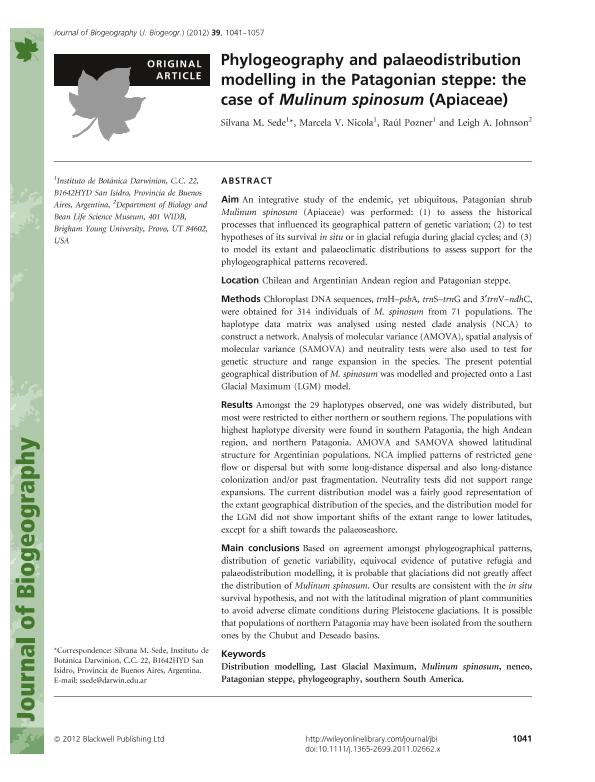Artículo
Phylogeography and palaeodistribution modelling in the Patagonian steppe: The case of Mulinum spinosum (Apiaceae)
Fecha de publicación:
06/2012
Editorial:
Wiley Blackwell Publishing, Inc
Revista:
Journal of Biogeography
ISSN:
0305-0270
Idioma:
Inglés
Tipo de recurso:
Artículo publicado
Clasificación temática:
Resumen
Aim An integrative study of the endemic, yet ubiquitous, Patagonian shrub Mulinum spinosum (Apiaceae) was performed: (1) to assess the historical processes that influenced its geographical pattern of genetic variation; (2) to test hypotheses of its survival in situ or in glacial refugia during glacial cycles; and (3) to model its extant and palaeoclimatic distributions to assess support for the phylogeographical patterns recovered. Location Chilean and Argentinian Andean region and Patagonian steppe. Methods Chloroplast DNA sequences, trnH-psbA, trnS-trnG and 3′trnV-ndhC, were obtained for 314 individuals of M. spinosum from 71 populations. The haplotype data matrix was analysed using nested clade analysis (NCA) to construct a network. Analysis of molecular variance (AMOVA), spatial analysis of molecular variance (SAMOVA) and neutrality tests were also used to test for genetic structure and range expansion in the species. The present potential geographical distribution of M. spinosum was modelled and projected onto a Last Glacial Maximum (LGM) model. Results Amongst the 29 haplotypes observed, one was widely distributed, but most were restricted to either northern or southern regions. The populations with highest haplotype diversity were found in southern Patagonia, the high Andean region, and northern Patagonia. AMOVA and SAMOVA showed latitudinal structure for Argentinian populations. NCA implied patterns of restricted gene flow or dispersal but with some long-distance dispersal and also long-distance colonization and/or past fragmentation. Neutrality tests did not support range expansions. The current distribution model was a fairly good representation of the extant geographical distribution of the species, and the distribution model for the LGM did not show important shifts of the extant range to lower latitudes, except for a shift towards the palaeoseashore. Main conclusions Based on agreement amongst phylogeographical patterns, distribution of genetic variability, equivocal evidence of putative refugia and palaeodistribution modelling, it is probable that glaciations did not greatly affect the distribution of Mulinum spinosum. Our results are consistent with the in situ survival hypothesis, and not with the latitudinal migration of plant communities to avoid adverse climate conditions during Pleistocene glaciations. It is possible that populations of northern Patagonia may have been isolated from the southern ones by the Chubut and Deseado basins.
Archivos asociados
Licencia
Identificadores
Colecciones
Articulos(IBODA)
Articulos de INST.DE BOTANICA DARWINION (I)
Articulos de INST.DE BOTANICA DARWINION (I)
Citación
Sede, Silvana Mabel; Nicola, Marcela Viviana; Pozner, Raúl Ernesto; Johnson, Leigh; Phylogeography and palaeodistribution modelling in the Patagonian steppe: The case of Mulinum spinosum (Apiaceae); Wiley Blackwell Publishing, Inc; Journal of Biogeography; 39; 6; 6-2012; 1041-1057
Compartir
Altmétricas




